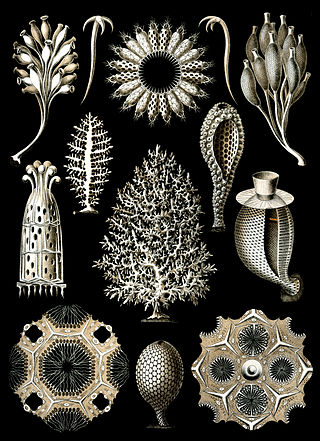
Sponges or sea sponges are primarily marine invertebrates of the metazoan phylum Porifera, a basal animal clade and a sister taxon of the diploblasts. They are sessile filter feeders that are bound to the seabed, and are one of the most ancient members of macrobenthos, with many historical species being important reef-building organisms.

The calcareoussponges are members of the animal phylum Porifera, the cellular sponges. They are characterized by spicules made of calcium carbonate, in the form of high-magnesium calcite or aragonite. While the spicules in most species are triradiate, some species may possess two- or four-pointed spicules. Unlike other sponges, calcareans lack microscleres, tiny spicules which reinforce the flesh. In addition, their spicules develop from the outside-in, mineralizing within a hollow organic sheath.

Leucosolenida is an order of sponges in the class Calcarea and the subclass Calcaronea. Species in Leucosolenida are calcareous, with a skeleton composed exclusively of free spicules without calcified non-spicular reinforcements.

Stromatoporoidea is an extinct clade of sea sponges common in the fossil record from the Middle Ordovician to the Late Devonian. They can be characterized by their densely layered calcite skeletons lacking spicules. Stromatoporoids were among the most abundant and important reef-builders of their time, living close together in flat biostromes or elevated bioherms on soft tropical carbonate platforms.

Minchinellidae is a family of calcareous sponges, members of the class Calcarea. It is the only family in the monotypic order Lithonida. The families Petrobionidae and Lepidoleuconidae have also sometimes been placed within Lithonida, though more recently they have been moved to the order Baerida. Thanks to their hypercalcified structure, minchinellids have a fossil record reaching as far back as the Jurassic Period.
Borojevia aspina is a species of calcareous sponge from Brazil. The species name refers to the lack of spines in the apical actine.
Clathrina aurea is a species of calcareous sponge from Brazil. Specimens of this species were previously misidentified with Clathrina clathrus
Clathrina ceylonensis is a species of calcareous sponge from Sri Lanka. The species name is derived from Ceylon, the former name of Sri Lanka.

Clathrina coriacea is a species of calcareous sponge belonging to the class Calcarea and family Clathrinidae. Species in the genus Clathrina are composed of calcium carbonate tube-like skeletons containing spicules. The sponge can be located in shallow waters widely distributed along North Atlantic coasts, as well as on other coasts.
Arturia dubia is a species of calcareous sponge in the genus Arturia from Australia. The species was first described as Leucosolenia dubia by Arthur Dendy in 1891. The name is derived from Dendy's uncertainty about the validity of the species, believing his specimens could, in fact, represent juvenile Leucosolenia cavata.
Clathrina hispanica is a species of calcareous sponge from Spain. The species is named after the country of Spain, where it was discovered.
Borojevia tetrapodifera is a species of calcareous sponge from New Zealand. The species is named after the presence of tetrapods, the only Clathrinid sponge known to possess such spicules.

Spicules are structural elements found in most sponges. The meshing of many spicules serves as the sponge's skeleton and thus it provides structural support and potentially defense against predators.
Heteractinida is an extinct grade of Paleozoic (Cambrian–Permian) sponges, sometimes used as a class or order. They are most commonly considered paraphyletic with respect to Calcarea, though some studies instead argue that they are paraphyletic relative to Hexactinellida. Heteractinids can be distinguished by their six-pronged (snowflake-shaped) spicules, whose symmetry historically suggested a relationship with the triradial calcarean sponges.
Clathrina antofagastensis is a species of calcareous sponge from Chile. The species is named after Antofagasta, Chile, where the holotype was discovered.

Arturia is a genus of calcareous sponge in the family Clathrinidae which contains 14 species. It is named after Arthur Dendy, a prominent researcher of calcareous sponges. It was renamed Arturia in 2017 because the name Arthuria was already assigned to a genus of molluscs.
Brattegardia is a monotypic genus of calcareous sponge with a single species: Brattegardia nanseni from Norway. The genus is named after the Norwegian marine biologist Torleiv Brattegard. The species is named after Norwegian helminthologist Fridtjof Nansen.
Amphoriscus is a genus of calcareous sponges in the family Amphoriscidae.
Sphaerocoeliidae is an extinct family of calcareous sponges, the only family in the monotypic order Sphaerocoeliida. Sphaerocoeliids are one of several unrelated sponge groups described as "sphinctozoans", with a distinctive multi-chambered body structure. Sphaerocoeliids persisted from the Permian to the Cenomanian stage of the Cretaceous, a longer period of time than most other "sphinctozoans". Sphaerocoeliids make up the majority of calcareous "sphinctozoans", as well as a large portion of post-Triassic "sphinctozoan" diversity. "Sphinctozoans" and the similar "inozoans" were historically grouped together in the polyphyletic order Pharetronida.







